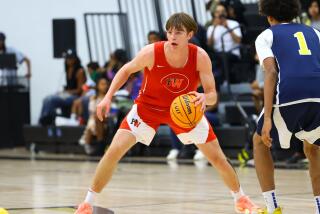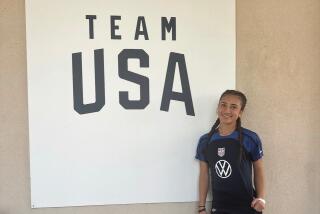Choosing a Winning School
Casey Wong, a star basketball player from the mid-San Fernando Valley with a 4.0 grade-point average, has been trying to decide what school to attend.
He toured four campuses, took an entrance exam, interviewed with school officials and sought advice from coaches, family and friends.
Hundreds of college-bound students face such gut-wrenching decisions each spring.
But Casey isn’t a high school senior. He is just 13 and picking a high school.
“It’s a big thing in my life,” he said. “It’s to see who wants me more.”
These days public and private high schools nationwide want students like Casey. And many parents--thinking of college scholarships or perhaps even the big bucks of professional sports--are debating the merits of high schools the way some young athletes compare UCLA and USC.
“It’s come to the point where I’ve run into families that shop around their child like a free agent,” said Gary Murphy, the principal at Chaminade High, a private Catholic school in the West Valley. “I’ve had people send in a highlight film. Last year, I received a packet a half-inch thick of athletic awards.”
Scott Drootin, Chaminade’s baseball coach, says parents of students as young as sixth grade have called to inquire about his program.
“It’s getting to be a brutal process,” Drootin said. “A lot of people think their kids are Mike Piazza and want to find a good home for them. I’ve never had it like this.”
It’s a national trend found in public as well as private schools and affects girls as well as boys. In basketball-crazy Indiana, for example, high school officials say some parents move to different neighborhoods or even new towns so their children can play for a strong high school program.
“It’s probably only going to get worse in terms of people wanting to shop their kids for athletic reasons,” said Bob Gardner, commissioner of the Indiana High School Athletic Assn.
In Tennessee, a dispute between public and private schools over financial aid and allegations of recruiting athletes as young as sixth grade resulted in 33 private schools being banned from playing public schools in playoff competition last fall. The private schools that offer financial aid were forced to create a separate division.
But in California the drive to place athletes at top-notch schools has taken on a wild urgency because of the open enrollment law passed by the Legislature four years ago, allowing students to attend any school in their district as long as classroom space is available.
The law was designed to encourage public schools to improve their academic programs, giving neighborhood students the option to look elsewhere.
But open enrollment has also cleared the way for parents to legally use sports as a determining factor in picking a high school, a process that becomes particularly frantic this time of year as districts open the application process.
Media Attention, Possible Scholarships
Nicole Murillo is an example of how the decision-making plays out.
Nicole lives across the street from William S. Hart High in Newhall, but the school’s convenient location didn’t guarantee that she would enroll there.
She’s an eighth-grade catcher for the Panthers Gold club softball team. In the past three years, 26 members of the team have received college scholarships, and Nicole’s parents hope that their daughter will follow suit.
So the Murillos considered three other public high schools in their district--watching the teams play, reading the sports section and talking with coaches--before settling on Hart.
“We’d like to have our daughter on a winning team and where the talent is,” said her mother, Donna Murillo.
California’s open enrollment law is only partly responsible for the school-shopping trend.
Club and youth all-star teams are expanding throughout the nation, leading to early identification of top athletes in all kinds of sports, from soccer and swimming to softball and basketball.
The media attention devoted to high school sports is immense. From Fox Sports West 2 broadcasting a game of the week to local cable stations providing live game coverage to newspapers running front-page team profiles, high school sports has never received more media exposure.
Many parents have invested thousands of dollars in sports camps, private coaches and expenses for travel teams, all in hopes that one day their child might earn a college scholarship or reach the professional ranks.
Bill Thomason, principal at Loyola High in Los Angeles and a former basketball coach, said the growth of club teams and the increasing reliance on private coaches is changing the perception of high school life.
“As early as the third and fourth grade, kids have some success and people tell them they’re fabulous,” he said. “Now they get up to eighth grade and they start thinking about college.”
Parents will say academics is a prime consideration when the search for a high school starts, but at softball diamonds and swimming pools, soccer fields and football stadiums, huddled groups of parents can be heard asking the same questions: How good is the coach? What kind of exposure to college recruiters does the program offer? Will my child be able to play on varsity as a freshman? How often does the team appear on television?
“It’s so out of control,” said Melissa Hearlihy, girls’ basketball coach at Alemany High in Mission Hills. “I think parents believe if they shop around and find the right high school, it’s going to guarantee a scholarship, and it’s not.”
The trend disturbs some parents, even as they shop for schools.
Margo Moss, a Sherman Oaks resident whose 14-year-old son, Steve, plays youth sports in the San Fernando Valley but attends Brentwood School on the Westside, said the growing importance of athletics complicates the high school decision process.
“Right now I’m hoping I’m not delusional that we’re getting the best of both worlds, getting good academics but also competing in Valley sports,” she said. “Socially he’s happy, academically he’s fine. To change everything to get his name in the paper, as much as we like it, I wonder how important that will be. In my generation, nobody would have made a decision about high school for athletics.”
High schools are not allowed to recruit athletes or give them priority for open enrollment slots, but they can send representatives to neighborhood middle schools to speak with perspective students.
David Doyle, chosen to take over as principal at Crespi High next fall, has the title of recruiting coordinator at the Encino campus. Just like high schools have college nights, Catholic grade schools have high school nights. Doyle’s job is to make a presentation selling students on Crespi.
“It’s our lifeblood,” he said. “We do it because people pay tuition.”
The high schools benefit too, of course, especially when it comes to publicity.
Balancing Priorities
When 6-foot-10 twins Jason and Jarron Collins graduated last June from Harvard-Westlake High in Studio City, they left more than a legacy of two consecutive state basketball championships. They brought unprecedented newspaper and TV attention to the school and helped the campus develop a new fan base while exposing the school to potential future students.
And so the search for the ideal school continues.
Lionel Schaen, who lives in Woodland Hills, decided to move his family to Orange County this month so his son, Harrison, already a 6-foot-5 basketball player at age 13, will be able to attend Santa Ana Mater Dei, a Catholic school with what is probably the most powerful athletic program in the region. It will also allow Harrison to live closer to his travel team coach, Pat Barrett, a former Mater Dei assistant under contract to Nike who is known for developing top young basketball players.
As for the 5-foot-11 Casey Wong, the letter he was hoping to receive arrived in the mail last month. It was from Crespi offering him a place in its 1998-99 freshman class.
“It came down to Crespi and Alemany,” said Marie Wong, Casey’s mother. “We’re really anxious. It’s a pretty big decision. Academics must come first, but right behind is athletics.”







